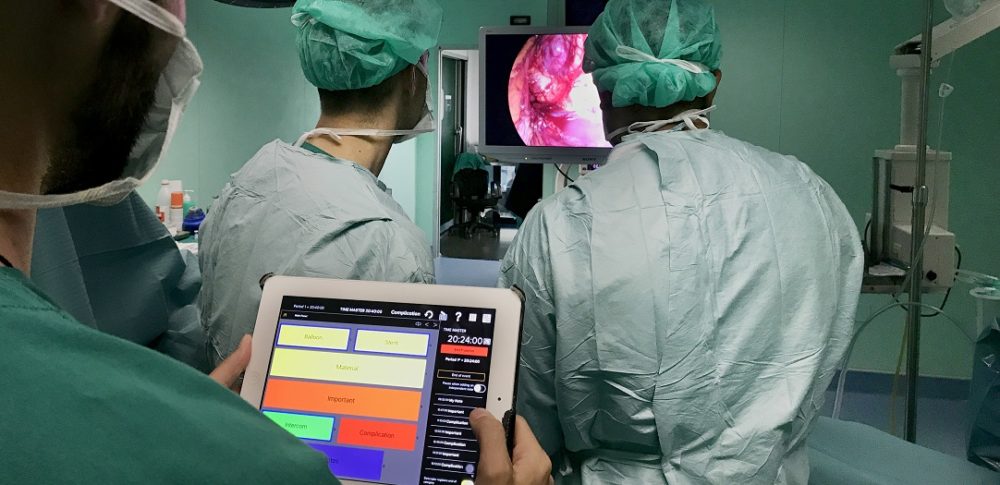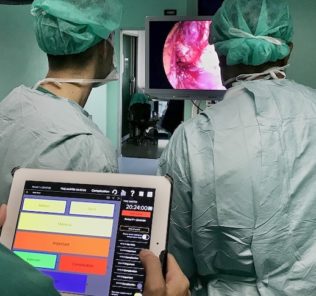How Codimg Video Analysis Supports Medical Simulation Training
With patient safety a growing concern among health authorities worldwide, one way of reducing the ‘care risk’ is to train staff in the specific areas patients are at most risk. Increasingly, organizations are turning to debriefing video analysis as a way of improving assessment and reducing the danger to patients. This article looks at the use of such techniques in a medical training hospital in the Canary Islands through the Codimg Video Analysis System.
Patient Safety has become a challenge and priority for health systems worldwide, with many international initiatives aimed at reducing the ‘care risk’, including the training of health professionals in Patient Safety. As part of this initiative, the Agency for Healthcare Research and Quality ( AHRQ ), in partnership with the Department of Defense (DoD), developed TeamSTEPPS 2.0 – a teamworking initiative offering an effective solution to improved communication within medical institutions.
Andrew F. Coburn, MD at Maine Health Research Center, shares that “Teamwork is one of the keys factors in patient safety. Communication and other collective skills are essential to provide quality care and prevent mistakes, injuries or damage in every type of medical intervention”.
Sponsored Content:
About the Motiva Foundation
Motiva represents technological innovation in the field of Minimally Invasive Reconstructive and Regenerative Surgery. Their objective is to create a stable platform of excellence across disciplines including; R & D and medical training as well as offering innovative technological services.
For Motiva members, training must integrate knowledge of clinical processes in conjunction with improvements in patient safety education. As part of this learning process, simulation in medical training is key, allowing the accurate recreation of a particular clinical event or technique, in the most realistic way possible. This methodology provides professionals with ongoing training and evaluation of their work. And the participation of students and experts also provides active teaching examples for future medical professionals.
Dr. Antonio Alarcó, Director of the Training Center in Robotics and Telemedicine, at the University Hospital of the Canary Islands (CERTEM-HUC), shared that “In current medical training simulation is essential, as it allows us to record, store, repeat, reproduce and transmit data. This allows us to permanently audit everything we are doing, and send the information to any part of the world”.
Sponsored Content:
Video is widely used across many areas of the medical world, as a tool for research, formative feedback, behavioral analysis or procedure. However, existing tools have been expensive and difficult to work with. Traditional video editing systems have required hours of work to verify observations and effectively support debriefing sessions.
In 2003, the Institute of Medicine (IOM) at the National Academy of Sciences of the United States established the need for “All health professionals should be educated to deliver patient-centered care as members of an interdisciplinary team, emphasizing evidence-based practice quality”.
Through debriefing professionals can engage in a joint reflection on the performance within a simulated session, highlighting what has been done well and should be repeated, or noting what has been done incorrectly, identifying errors, analyzing their causes and working to correct them.
“We have developed a model in which we take into account the participation of different users, process training, team structure, leadership, their assessment of the situation, mutual support and communication as key elements for the improvement of students and professionals” , according to one expert at the Center of Training in Robotics and Telemedicine at the University Hospital of the Canary Islands ( CERTEM-HUC ).
Regarding the development approach taken by TeamSTEPPS 2.0, “We have worked to adapt it to our context, using simple and effective indicators, incorporated into our criteria template. This has given us a common language to analyze what is happening and achieve the objectives proposed during different simulation exercises. We understand that we cannot study to forget. Thanks to video analysis we have a tool for updating, learning and storing health-related information”.
Codimg’s Commitment to Simulated Training
According to Dr. Beneharo Darias , Assistant Medical Instructor of Anesthesiology, Resuscitation and Pain Therapy Service at the University Hospital of the Canary Islands: “Our vision is that each member of the medical team receives comprehensive training through both medical practice and simulation exercise. This requires a significant investment of time by medical professionals with training responsibilities. For us, harnessing the power of video in our daily practice is essential to achieve a quality simulation and make the most of this time investment. Our experience dictates that the use of video analysis significantly improves the accuracy and quality of conversations during debriefing”.
“One of the clearest benefits of using video in this context is th e provision of a clear and objective record of what happens during simulation. It is scientifically proven that an image is processed much faster and is easier to remember than written or spoken text . W hen we observe ourselves performing an action, we awaken emotional intelligence, further helping our memory of events ” , adds Darias.
“Having the precise record of an action, provided by video analysis, helps overcome the inevitable difficulties that users have to accurately remember what was said and done during a simulation exercise. Codimg allows us to be objective about our analysis. The theory is directly supported by first-hand evidence gathered from our own experience of d ebriefing. V ideo also provides an integral and concrete context: being able to clearly see the behaviors and communication between participants, offers us another point of reflection that otherwise would have been lost” , concludes Doctor Beneharo .
About Codimg and Codimg View
Dr. Manuel Maynar Moliner, director of Medical Technology at ULPGC speaks about Codimg and its applications: ” Codimg is a tool that helps us be much more specific and precise in our analysis, syncing sections of recorded video with our observations. This we can do because the software has the ability to adapt to our needs, allowing a learning framework to be superimposed over the practical element of our training”.
“In particular within the ECOE (The Examination of Objective and Structured Competences), it helps us evaluate specific skills, facilitating reflection on those aspects to improve within the training of a professional, thereby adding objectivity.
As a versatile technology, we have taken advantage of video analysis methodology for different technical requirements within the operating room; in Endovascular Training Workshops and with specialists in cardiac and urological surgery, using live sessions” , adds Maynar.
“Also, in the field of simulation we have used Codimg for an Advanced Simulation Course in Critical Situations or Advanced Clinical Simulation Workshop of Frequent Intraoperative Complications in VIDEO Anesthesiology” , explains Dr. Beneharo .
Another highlight of video analysis for Dr. Maynar is: “The precision video offers and its importance in the analysis of process. Communication, participation and processes are much easier to analyze and improve on, when captured in a movie. It allows members of a multidisciplinary team to transmit information effectively. In this sense, feedback, both formal and informal, creates information of capital importance for improving the performance of the team and of each professional within it”.
The system’s versatility and simplicity of extracting meaningful actions using Codimg’s iPad or iPhone application are other virtues highlighted by Dr. Beneharo Darias : “Once installation is complete it is simple to work with. We have been using the Codimg View application on an iPad Pro to capture video. This means instructors can use it anywhere in the medical environment – without having to ask IT for help setting up. Together with the main software, we mark the video using our own template: with customized categories and descriptors. This has replaced any type of subjective annotation in notebooks, which were being used previously, but which could not offer precise details. Through the recording of actions from various angles, we review tagged videos, comparing and organizing recorded actions”.
For Dr. Darias : “A very useful tool within Codimg is the data panel. This shows statistical information in the form of visual graphs and tables. These are linked to the video recording, providing us with a visual catalog of examples that have helped us to support students using a smart board.
Additionally, instructors can use the presentation function to generate a sequence of tagged clips that can be easily accessed during debriefing sessions. The clips can be added to a presentation at the click of a button and the running order can be changed. So you can optimize timings and quickly concentrate on the most important moments in your footage”.
“Once the students finish their training, we all meet in the debriefing room and discuss the simulation. As instructors, we usually set some goals during training sessions. For example, we may be looking at team working skills – how doctors coordinate during surgery or more specific areas such as tracheal intubation in patients.
Primarily we see our task as facilitating the students through analysis, of performance in the operating room, and feedback. We guide them in terms of what we review, discuss and watch. What is important and what is not”, concludes Darias .
Value Contribution From Codimg and Video Analysis for Debriefing
The real value of Codimg is its ability to recognize training elements and reproduce key moments, to provide genuine and immediate debriefing. It also helps users to reinforce and mark positive areas of their training, with a better assimilation and subsequent application of what they have learned, from the perspective of passive observer.
Watching short videos of your own actions are always a powerful self-assessment tool, especially if you can tag and catalog images as they are captured. Based on David Kolb’s experiential learning model, we encourage a deeper self-reflection of our staff.
Experiential learning is seen as a four-stage cycle :
- The immediate and concrete experiences which serve as the basis for observation.
- Next, the individual reflects on these observations and begins to construct a general theory of what this information may mean.
- Abstract concepts and generalizations are created by the observer, based on their hypotheses.
- Finally, the student tests the implications of their concepts in new situations.
With its simple and intuitive format, Codimg’s audiovisual performance analysis system allows you to set the parameters and report on a wide range of activities, including residential practice, simulation, communication within multidisciplinary teams etc. improving the quality of training through qualified feedback.
Learn more about Simulation Video Analysis with Codimg Today!
Today’s article was guest authored by Enrico Caballero, Communications Manager at Codimg.
Have a story to share with the global healthcare simulation community? Submit your simulation news and resources here!
Sponsored Content:
















